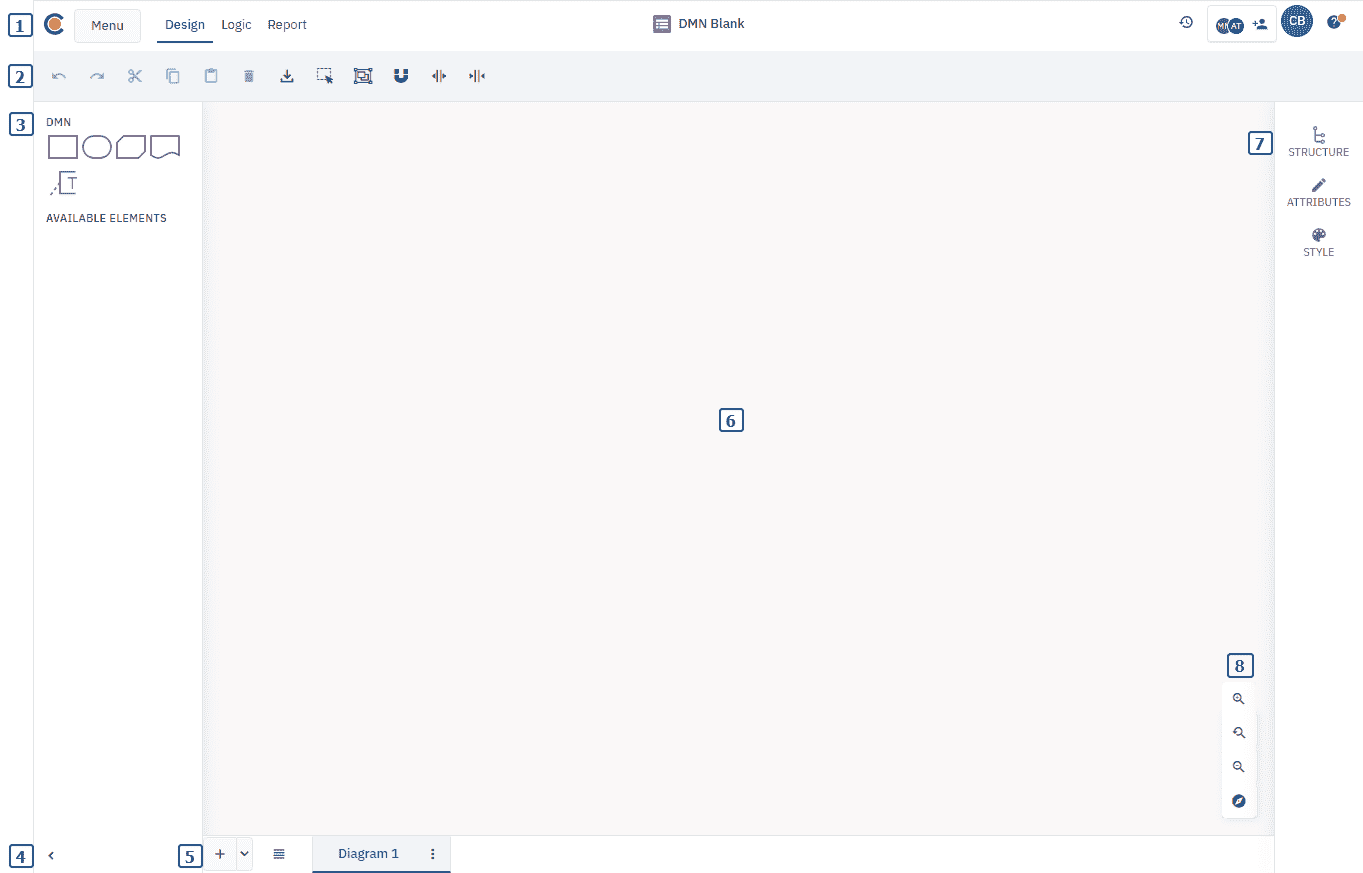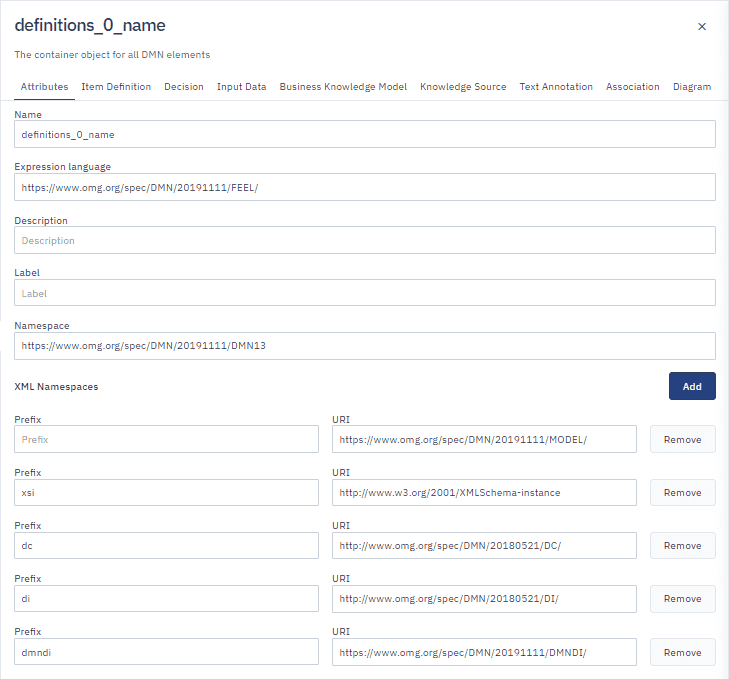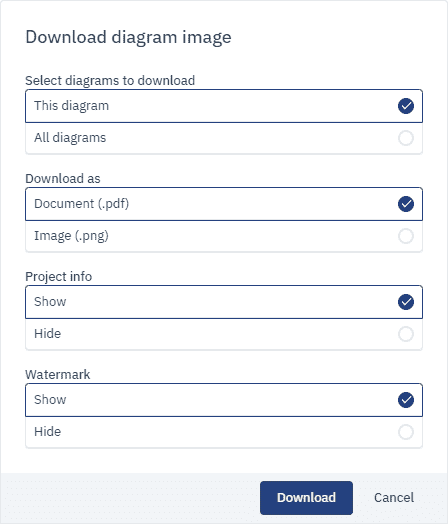Decision Requirements Diagrams
In any DMN model, you start by creating a Decision Requirements Diagram (DRD). A DRD is the visual representation of a DMN model, known as a Decision Requirements Graph (DRG). A DRG can consist of one or more DRDs or diagrams.
You model Decisions in diagrams using a standard palette of components.
You can have multiple decisions in the one diagram or spread them over multiple diagrams to avoid complex decision models that are difficult to read.
Before you start modeling your decisions, get to know how diagrams work, how to format them, configure decision definitions, view decision structure and reports, and download decision models and images.
Tour the Design page
Before you start, get to know the DMN Design page. The Design page is where you model and edit decisions.

-
Header:
-
Cardanit logo: click to go to the Home page.
-
Menu: Go to My Files, rename the project, and navigate to the Simulations page which lists the simulations that have been run.
-
A tab menu that gives you access to the Design, Logic and Report pages.
-
The project name.
-
Access to version history.
-
See who the project is shared with and share the project with others.
-
View your profile.
-
Access the help section.
-
-
Toolbar
Use the toolbar to access key functions. Select the
icon to open the Navigation panel. The toolbar also includes options for editing the BPMN model and downloading the diagram or model screenshot. -
Navigation panel
The Navigation panel shows the components you can use to map your decision model.
-
Diagram
This is where you create, map and edit your decisions.
-
Configuration panel
Navigate and customize your DMN model. The Structure tab lets you explore the decision structure, while the Attributes and Style tabs allow you to configure component properties and appearance.
-
View toolbar
The View toolbar provides tools to adjust your view of the diagram. Use it to zoom in, zoom out, reset the view, or open the mini-map for easier navigation of large or complex diagrams.
-
Diagram tab bar
Manage and switch between multiple DMN diagrams. Add new diagrams, rename them and switch between diagrams.
Manage diagrams
You can add, rename and delete diagrams and move diagram tabs in the sequence you prefer.
You perform these actions in the diagram tab menu at the bottom of the screen.

Add a diagram
To add a diagram:
-
In the diagram tab bar, click
. This places the diagram at the end:
You can also choose where to add a diagram: at the start, at the end, right or left.
- In the diagram tab bar, click
and select an option.
Rename a diagram
-
Click
, then click Rename. -
In the dialog box that opens, give a name to the diagram, then click Ok.
Delete a diagram
If you delete a diagram it can’t be restored.
- Click
, then click Delete.
Move diagram tabs
You can move diagram tabs in the sequence you prefer: left,right, to the start or end.
-
Click
, then click Move right, Move left, Move to start or Move to end. Or select the tab and drag and drop into position.
Format diagrams
You can customize the appearance of components and labels to make your diagram clearer and easier to read.
To customize the style of a component in your diagram:
-
Select the component, then click Style in the Configuration panel.

If you don’t like your style changes, click Reset to return to the default style.
To select multiple components of the same type — for example, all the Decisions in the diagram:
-
Press Shift, then select all the components you want to format.
In the Style panel that opens, depending on the type of component you want to change, you have these formatting options:
Element
Format the color of components.
Fill: color the inside of a component.
Stroke: color the outline of a component.
Text
Format label text and paragraph styles.
Text: change the font type, font size, color and text style, align text and position.
Edge
Format the appearance of Knowledge, Information and Authority Requirements and Associations.
Color: Color the line.
Style: Choose between straight and elbow.
Radius: Change the curve radius.
Configure Decision Definitions
Definitions is the root container for all the components of a DMN decision model. Cardanit automatically detects and lists all the Definitions in the DMN model.
You add, edit and remove Definitions in the Definitions panel. Alternatively, you can configure Definitions using shortcuts in the Attributes panel of certain Elements.
The Definitions panel is divided into tabs.

Open Definitions
- Click anywhere in the diagram and in the Configuration panel, click Attributes.
Add a definition
This action is applicable to all Definitions except for Attributes.
-
Open the tab of the Definition you want to add, then click Add.
-
Select the Definition and complete the Definition fields.
Edit a definition
- Select the Definition and edit the Definition fields.
Remove a definition
This action is applicable to all Definitions except for Attributes.
-
Open the tab of the Definition you want to remove.
-
Select the Definition, then click Remove.
Explore decision structure
The Structure panel displays all the aspects of a diagram in alphabetical order in a real time, synchronized tree structure.
When you add something to a diagram, the Structure panel updates in real time to reflect what you see in the diagram.
When you select an element in the diagram, the element is highlighted in the tree. Once you’ve selected an element you can open the Attributes panel to define its attributes.
Use Search to explore the structure and find a specific item in the diagram.

View the decision report
Cardanit generates a comprehensive decision report that enables you to analyze processes offline in a familiar format.
The report is generated in real time and contains all the diagrams in the decision. It includes everything from Attributes and Definitions to diagram graphics and images.
Preview and download the process report on the Report page. You can download the decision report in Microsoft Word DOCX and Adobe PDF format.
Download report
- In the Toolbar, click
 for DOCX or
for DOCX or  for PDF.
for PDF.

Download DMN file
You can download diagrams as a DMN 1.3 XML file to back up your work or to use with other DMN-compatible software.
You download DMN 1.3 XML files on the Design page.
- In the Toolbar, click
.
Download diagram image
You can download an image of a single diagram or multiple diagrams as a PDF or PNG file.
You download diagram images on the Design page.
-
In the Toolbar, click
. -
In the dialog box that opens, select which images to download, the file format and show or hide project information and the watermark, then click Download.
